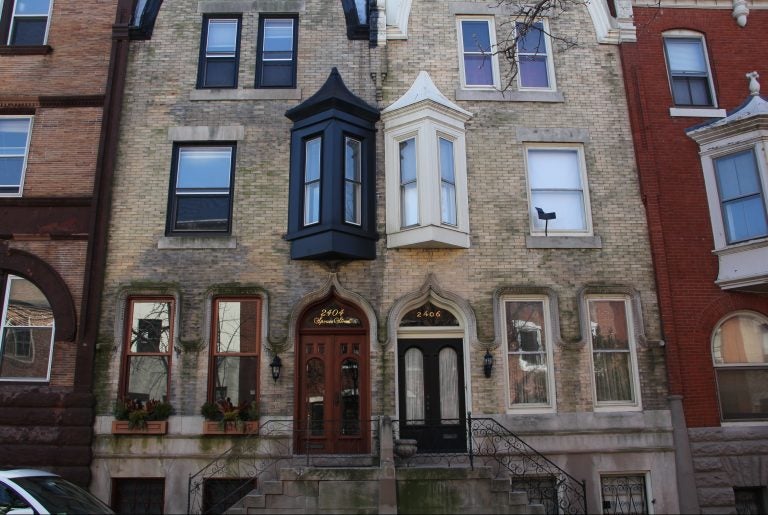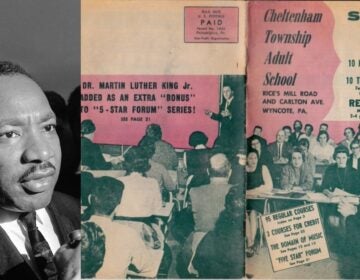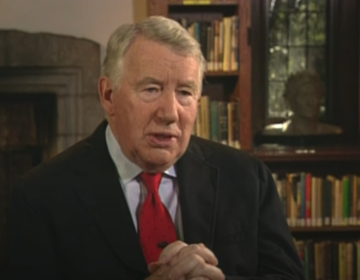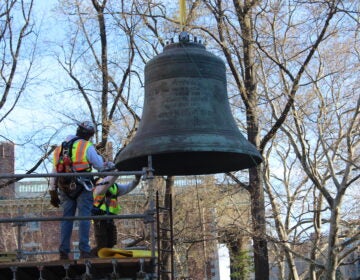‘Rowhouse’ vs. ‘rowhome’? The tangled history of a uniquely Philadelphia term
Nothing gets Philadelphia grammarians riled up more than a question of local dialect. Enter: the debate over Philadelphia’s most common building.

Rowhouses line Spruce Street in Fitler Square. (Emma Lee/ WHYY)
This story originally appeared on PlanPhilly.
Is it “rowhouse” or “row house?” Is it “rowhome” or “row home?”
Nothing gets Philadelphia grammarians riled up more than a question of local dialect. Especially when there is no clear answer, and the spelling of Philadelphia’s most common building is no exception. But the history of such an unremarkable word is surprisingly mysterious –– and almost as tangled as the long history of the humble rowhouse itself.
The very term “rowhouse” is a defining part of Philadelphia’s mid-Atlantic dialect –– most other regions preferring “townhouse” or “brownstone” or “terraced house.” yet the murkiness of the word’s evolution likely fuels the debate today over which is “correct.”
Today, modern readers, quizzed by this WHYY reporter, indicated they overwhelmingly prefer “rowhouse” to “row house,” regarding the latter as a waste of space.
Please don’t waste our precious typographical space. Make it one word!
— Inga Saffron (@IngaSaffron) August 9, 2019
But a small war could still be waged over whether it’s “rowhouse” or “rowhome.”
I use rowhome. But I have used rowhouse in certain circumstances.
— Kevin Harden, Jr. (@KHJ_Esq) August 10, 2019
Yet these spellings have alternated in popularity over the years. More strikingly, for much of the city’s history, almost no one seems to have used the word at all.
How ‘rowhouses’ became a thing
Early on, colonial buildings were rarely built in proper “rows” and were often detached or semi-detached, owing to less formalized construction practices and wider availability of open land at the time. Architectural historians often cite the 1799 construction of “Carstairs Row,” at the site of what is today known as Jeweler’s Row, as a kind of origin point for modern rowhouses.
Designed by architect Thomas Carstairs, the string of Sansom Street homes were intentionally built in a uniform, look-alike row. This method would gain popularity during the city’s boom years in the mid-to-late 19th century, but at that time there was no singular term to describe the style of construction — it was just “a row” or “a row of brick dwellings.”
For over a century, the shorthand rarely appeared in print. A search of the Philadelphia Inquirer’s news archives back to 1860 turns up zero 19th-century uses of shorter terms like “row house,” “row home,” “rowhouse” or “rowhome.” In 1912, a front-page Inquirer report on overcrowding still refers only to Philadelphia’s “long rows of dwellings.” Not once did journalists use “rowhouse,” even though the term and others like it were almost certainly part of local dialect by then.
The few early examples of “rowhouse” usage around this time come almost exclusively as part of Inquirer real estate advertisements. These ads indicate that phrases like “row of houses” were surely the predecessors of “rowhouse,” according to the paper’s current style expert, David Sullivan.
The latter term developed, in part, as a space-saving technique for classified ads that charged by the word, Sullivan believes. But the term’s popularization, however, he said, may have been fueled by an age-old competition: Philly versus New York City.
‘City of homes’ vs ‘tenement city’
Philadelphia was still something of a peer to New York City in the early 20th century, but the Big Apple’s population was rapidly dwarfing William Penn’s town. Around the time of the Centennial Exposition in 1876, civic leaders thought to promote the city by emphasizing quality over quantity.
“The ‘Philadelphia House’ shown at the 1876 World’s Fair was sort of a model of better housing,” Sullivan said.
Boosters began to use the term “city of homes” around this time, contrasting Philadelphia’s many single-family houses with the crowded slums of New York.
National Park Service historian Amanda Casper, who studied the architectural history of the rowhouse, links the rise of the rowhouse terminology to this early PR campaign.
“It’s probably related to branding,” Casper said. “There was competition between Philly and NYC, and contrasting ‘the tenement city’ with ‘the city of homes.’”
Even public-housing crusaders of the time, whose motivating purpose was to eliminate overcrowding, sometimes alluded to this rhetoric.
“While we are in a far greater extent than New York a ‘city of homes,’ and thousands of our population have their own private dwellings, there are other thousands existing in buildings scarcely fit for human habitation,” wrote one early housing advocate in 1909.
Although the phrase “city of homes” is still occasionally bandied about today, it reached its peak usage in the 1920s. And Casper’s theory holds that flapper-era real estate agents pushed the messaging, underscoring in their advertisements that they were selling entire houses and a superior style of urban home.
By 1930, the term took on a rapid rise, even in newsprint. Sullivan thinks this can be linked to newspaper spelling reforms of that decade, which pushed to shorten and standardize print copy as much as possible. In 1942, the one-word use of “rowhouse” appeared in the Inquirer for the first time ever.
This remained the standard rendering in 1983, when Sullivan began to work at the paper. Originally from Indiana, he was quickly instructed how to describe this local peculiarity.
“We called them ‘townhouses,’” he said. “The concept of a rowhouse was utterly foreign in Indianapolis. I had to explain to my mother what they were.”
Which brings us to why the debate over the architectural term extends only so far geographically. The mid-Atlantic region is one of the only places in the United States where the dominant mode of housing in big cities is the attached single-family home.
The same questions plague rowhouse-rich cities like Baltimore. When The Baltimore Sun and The Evening Sun merged over two decades ago, one newsroom had used a two-word rendering that appears in Merriam-Webster’s dictionary, while the other had gone with the one-word reader favorite. The latter won out, although that decision still generates controversy today.
Is there a right way to spell Philly’s favorite dwelling?
So, all that said: Which is the “right” way to spell it? And it is a “rowhouse” or a “rowhome?”
News organizations often follow the lead of national outlets, like the Associated Press, for spelling and grammatical choices. But because of the intense localization, there is no real authority on this subject outside of this region. The AP is silent on the topic. And while Merriam-Webster favors the two-word rendering, it says either spelling can be correct.
At one point, the Inquirer stylebooks explicitly instructed editors to ignore dictionaries that rendered “rowhouse” as two words in favor of the single term. But today, the one-word version is so dominant that this note has vanished at the Inquirer –– though “rowhome” still gets short shrift.
“Our policy is to never say ‘rowhome’ except in quoted matter,” Sullivan said.
Those who prefer the cozy rowhome to the sterile rowhouse will find little help from higher authorities.
William Labov, a retired University of Pennsylvania professor, has quite literally written the book on the Philadelphia dialect. But even he was at a bit of a loss.
“I didn’t know there was this issue on what to call it. But it’s not surprising, given many other local terms, like ‘pavement,’” he said, referring to the controversial Philadelphianism for what most regard as a ‘sidewalk.’
His personal preference?
“I’ve always used the term ‘row house’,” Labov said, citing the two-word spelling. “But I’m not a local.”
WHYY is your source for fact-based, in-depth journalism and information. As a nonprofit organization, we rely on financial support from readers like you. Please give today.







